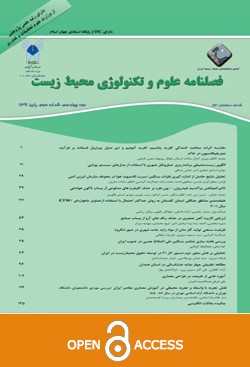Evaluating the effects of smart city development with an emphasis on sustainable development components
Subject Areas : Architecture and urbanismmalihe ahmadi 1 , مرتضی عمرانی 2
1 - Department of urban planning, College of technical and engineering
Shahre-e-Qods Branch, Islamic Azad University, tehran,, Iran
2 -
Keywords:
Abstract :
Introduction: Growing world population and major trends towards urbanization, will have catastrophic effects on the environment and urban spaces. This study aimed to save resources, time and energy in cities, is about the concept of "intelligence" in the city and identify effective methods of improving the quality of urban life.
Material and method: According to the study, with approach "descriptive-analytical", to identify "features smart city" as indicators discussed, by calculating a score for each indicator, and evaluate them, the most effective results of intelligent cities are determining.
Results: This study reveals the need and cost of smart cities, is creating the city-wide infrastructure, not only from an economic perspective as well as optimizing their profitability, but also it is desirable to promote the quality of citizens life.
Conclusion: The results of the review of the final table, which is reflected in its, show the "Creating the macro economy" has been the largest numeric quantities and as a result, the effect is maximal for smart cities. Other important factor is the possiblity of " accessibility" for detailed information about creating smart cities.
1. http://vista.ir/content/11789
2. قیسوندی، حمید، آرمان قیسوندی و کیهان قیسوندی، 1390، «شهر هوشمند، تکوین انقلاب شهری نوین»، "شهراکترونیک واقعیت شهرهای فردا"، نخستین همایش ملی آرمان شهر ایران، نور، دانشگاه آزاد اسلامی واحد نور
3. کیانی، اکبر، 1390،"شهر هوشمند ضرورت هزاره سوم در تعاملات یکپارچه شهرداری الکترونیک(ارائه مدل مفهومی، اجرایی با تاکید بر شهرهای ایران)"، فصلنامه جغرافیایی آمایش محیط، شماره 14
4. Breheny, M. (1995) "Conterurbanisation and sustainable urban forms, in Cities in Compatition” (eds J. Brotchie, M. Batty, E. Blakely, P. Hall and P. Newton), Longman Australia, Melbourne.
5. UN DESA continent population 1950 to 2100.svg
6. Banister, D, Watson, S. andWood, C. (1997)” Sustainable cities, Transport, Energy, and Urban Form, Environment and planning” B,24(1)
7. http://www.imagesgoogle.com/smartcity
8. Brotchi, J, Gipps, P.and Newton, P. (1995) ” Urban landuse, transport and the information economy : metropolitan imployment, journe to work trends and their implications for transport”, Urban Futures,17.
9. Castells, M. (1989) ”The Informational city : Information Technology, Economic Restructuring and the Uban Regional Process”, Blackwell, Oxford.
10. Troy, P. (1996) ” Urban consolidation and the family, in The Compact City : A Sustainable Urban Form ” (eds M. Jenks, E. Burton and K. Williams), E & FN Spon, London.
11. Gordon, P, Kumar, A.and Richardson, H.W. (1989) ”The influence of metropolitan spatial structure on commuting times”. Journal of Urban Economics,26.
12. Marcus, Jason, 1997,” The Invironmental and Social Impacts Of Telecommuting and Teleactivities” : Chpt :7, at : http://www.oldgrowth.org/Telecommute/7reduction-auto.html.
13. Dittmar, H.and Cook, K,1997, ” Mean Streets Pedestran Report”, at : http://www.transact .org/mean/for/html.
14. Quay, Ray,1993, Telecommuniting : ”Possible Futuers For Urban & Rural Communities”, Planning Commisionals Journal Vol :12 :16
15. Graham, Stephan,1995. ”Cyberspace and the City”, T & CP journal :198.
16. Bursuk, Mark,1996. ”What Is The Impafct Of Infotech On Commerchial Real Estate”, Presented To : Real Estate Roundtable Stanford Business School Alumni Association, at : http//www.telecommute.org/brusk3.html

